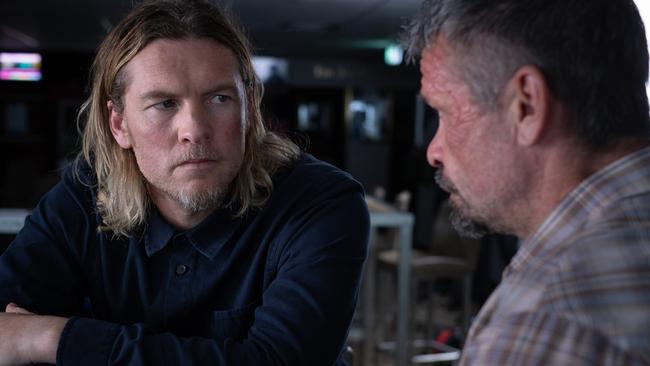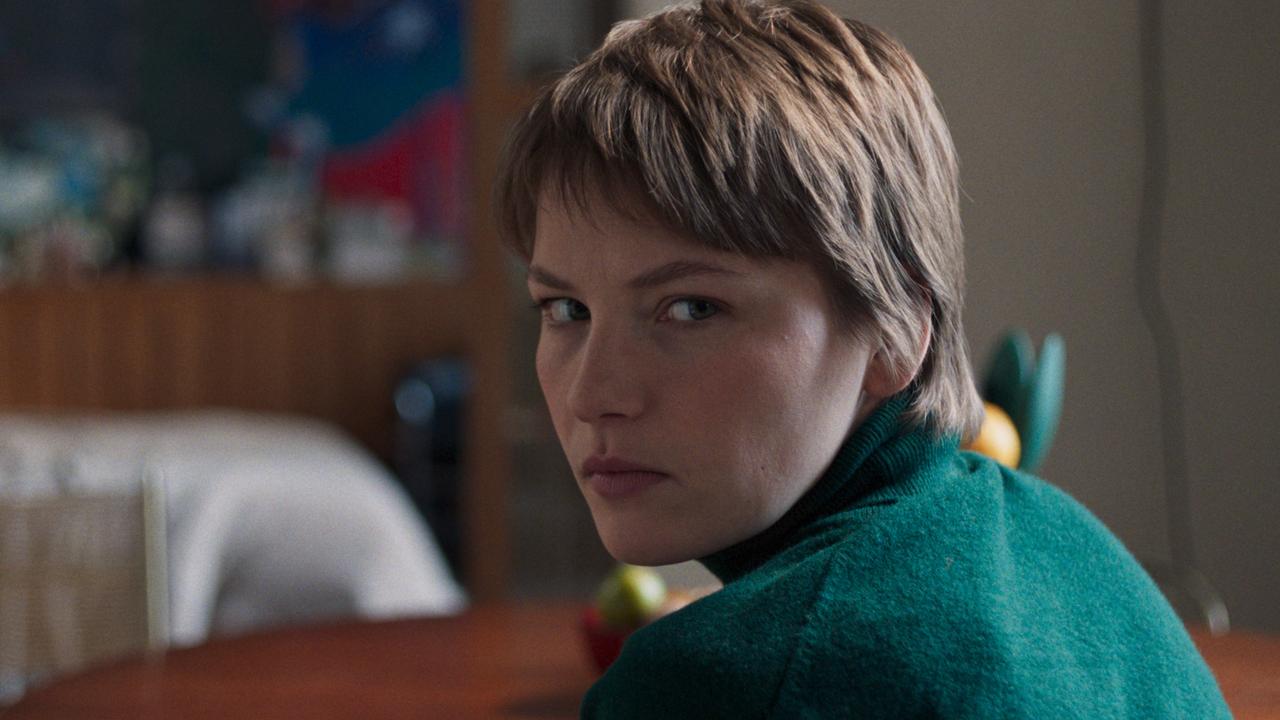Sam Worthington at his best in Matt Nable’s Transfusion
If you want to see what a fine actor Worthington is, watch Tranfusion instead of Avatar. As a former sniper home from war, his performance is devastating.

Transfusion (MA15+)
Stan
★★★★
The Australian drama Transfusion is written and directed by the Sydney rugby league player turned novelist and actor Matt Nable. He deserves the cinematic equivalent of man-of-the-match for this hard-hitting directorial debut.
This is a movie about men who return from war. It will not be used as an armed forces recruitment advertisement.
The script is unflinching and the performances are powerful: Nable himself, newcomer Edward Carmody and Hollywood star Sam Worthington.
If you want to see what a fine actor Worthington is, watch this rather than James Cameron’s Avatar: The Way of Water. The latter is spectacular to look at but it’s not a film where acting matters that much.
Worthington is Ryan, a former SAS corporal. A sniper, he saw service in Iraq and Afghanistan. Nable is Johnny, his former battlefield commander. Carmody is Billy, Ryan’s troubled 16-year-old son.
That’s who they are in the present. This 105-minute movie shifts between three connected time frames. In the first, which is brief, Ryan and Johnny are fighting in Afghanistan.
In the second, Ryan tells SAS recruits they must walk a line between “courage and fear”. He and wife Justine (Phoebe Tonkin) are expecting their second child. Billy is eight. It’s in this sequence that the meaning of the title, Transfusion, comes into devastating effect. Post-traumatic stress disorder is not limited to a war zone.
In the third and main time frame, Billy is 16 and in trouble with the police. Ryan, who finds it hard to hold down a job, fears his son will be sent to juvenile prison.
He reconnects with Johnny and the two start working together in the shadier streets of Sydney. “It’s what we’re good at, corporal,’’ Johnny tells him.
Johnny, hard as nails on the surface, still calls Ryan “corporal” and “son”. After they do some brutal work together, he says, “You’re a soldier. You did what you had to do.”
The trouble is, they are civilians, not soldiers. Together they blur that line between courage and fear into something for which no one will ever receive a medal.
This movie explores important issues involving military personnel such as PTSD, the impact on family life, and the general post-conflict treatment of veterans.
Ryan feels he does not receive the respect he deserves for what he did when in uniform.
When Johnny is asked if he regrets killing people on the battlefield, he replies, “You kill someone and after you wonder how your paths crossed.”
Worthington and Nable bristle with caged – and sometimes uncaged – hostile masculinity. Cinematographer Shelley Farthing-Dawe brings them together, often in close up, in a way that is subtle yet disturbing.
Billy is dominated by his father. Not physically but emotionally. He has some idea of his dad’s main – perhaps only – skill set. “Will I be brave like you one day?” eight-year-old Billy (Gilbert Bradman) asks him. That emotional distance between them only seems to increase over time.
This is personal for Nable, who grew up an army kid, moving from place to place in line with his soldier father’s duties. He could have taken this movie to lots of different places.
Where he does take it is impressive in its determination to tell a particular story about two returned soldiers. They are shells of men. They do not represent the entire armed forces. The ending is almost perfect.
There is little humour in this movie and that’s OK. Some stories don’t have room for jokes. They are still worth telling.
-
The Subtle Art of Not Giving a F..k (M)
Digital release including on Amazon Prime, Google Play, Fetch, Microsoft, Telstra TV and YouTube
★★
The American author Mark Manson is smart enough to take the mickey out of himself in the opening scenes of The Subtle Art of Not Giving a F..ck, a documentary based on his mega-selling 2016 book of the same name.
He speaks to us from a inflatable raft in a swimming pool as beautiful young women do some synchronised swimming around him. He sips from a hollowed out pineapple with a cocktail umbrella in it.
He admits the film studio, Universal, has paid him “I don’t know how much money”. He hints that one of the reasons his book has sold 15 million-plus copies is because it has the f-word in the title.
This is wise of him on two counts. First, it suggests there’s a chance he does not take himself too seriously. Second, it means we, if we choose to, can consider his anti-self help philosophy to be poppycock.
I’m in that camp. I think that while the book asks some valid questions about the narcissism of contemporary life, its philosophical answers are an overreach.
Of course, this is only my opinion. If other readers have used Manson’s book to put their lives back on track, good for them. Indeed, if his manifesto has saved one life – suicide is an undercurrent here – then it is a good book.
This 97-minute film, directed by New Zealand filmmaker Nathan Price, essentially is the book on screen. Its overall aim is to help us “become less awful people”.
Broadly speaking, Manson’s worldview tweaks the proverb “If life gives you lemons, make lemonade”. His advice is, and I’m paraphrasing, “f..k lemonade; learn to suck up the f..king lemons.”
Manson is 38. He grew up in Austin, Texas. He talks, once he is out of the pool, about his childhood, teen and young adult years, which had “traumatic shit” moments, but not disastrous ones.
One of his go-to themes is that modern life depends on a sense of entitlement. He notes that every child at school sports carnivals receives a medal, not just the winners.
I agree with this point.
I also agree that social media makes a lot of people feel mundane. Why aren’t we all doing a selfie with Brad Pitt or Margot Robbie on the top of Everest and so on.
But that’s just the world as it is. It can be annoying but it’s bearable.
It’s not a social apocalypse, as Manson calls it. And when it comes to entitlement, he does not mention his own multimillion-dollar wealth or the fact that his speaker’s fee is as much as $US100,000 ($144,000). Again, good luck to him. It’s when he starts going on about how the cornerstone of living is that life is pointless and we’re all going to die that he loses this viewer.
Our awareness of the mortal coil should be our saving grace, he tells us. As life is short, we should use it well.
“Life is painful, you’re limited and no matter what you do it’s always going to be that way,’’ he says.
“Ninety-nine per cent of the shit going on in your daily life doesn’t f..king matter.”
“The more I think about my own death, the brighter my life gets.”
He introduces chapters of the movie with titles such: Happiness is a Problem and You Are Not Special and adds asides such as Love Never Works Out. I disagree on all counts.
As this is a film, not a book, Manson needs to illustrate his intellectual blueprint with visual examples. There’s a lot of predictable borrowing from old films, but the two main stories he draws on are perplexing.
One is the Japanese soldier Hiroo Onoda, who fought World War II for three decades after it ended; the other is the thrash metal musician Dave Mustane, who moved from Metallica to Megadeth.
Manson’s philosophical solution is not to jump from a cliff – though he does stand at the edge of one during the film – but to work out the precious few things in life that are worth giving a f..k about and live for them. Everything else can be consigned to the not giving a f..k basket.
“Death must be the compass that guides which f..ks to give,’’ he says.
And anyone who needs help reading that compass can consult one of the stars of the book, Disappointment Panda, who makes a brief appearance in the film. He forces people to face up to the “harsh truths about themselves”.
Now, I like pandas, but I have to say, as a philosophical, moral and ethical code, none of this is particularly f..king subtle.




To join the conversation, please log in. Don't have an account? Register
Join the conversation, you are commenting as Logout